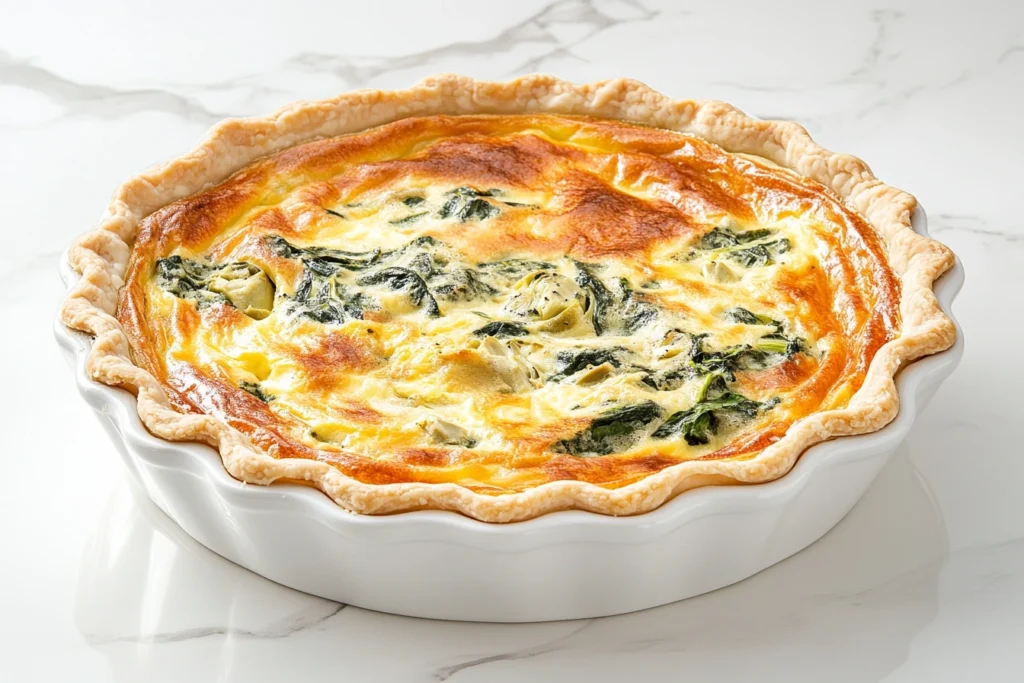Spinach artichoke quiche isn’t just a brunch dish—it’s what happens when your favorite dip decides to grow up and get fancy. Creamy, cheesy, and packed into a flaky crust, it’s basically comfort food in a pie pan. Whether you’re feeding brunch guests or just showing off to yourself (no shame), this savory stunner is ridiculously easy to whip up—and even better the next day… if it lasts that long.

Table of Contents
Spinach and Artichoke Nutritional Benefits

Sure, spinach artichoke quiche is creamy, cheesy, and soul-warming—but it’s also surprisingly nutrient-packed. These two powerhouse veggies aren’t just for flavor—they come with serious health credentials. Let’s dig into what makes spinach and artichokes so good for your body.
– Are spinach and artichokes good for you?
Absolutely. Both spinach and artichokes are low in calories but rich in fiber, antioxidants, and essential vitamins. When you bake them into a quiche, they sneak powerful nutrients into each slice.
Spinach: The leafy green MVP
| Nutrient | Benefit |
|---|---|
| Iron | Supports healthy red blood cells |
| Vitamin K | Crucial for blood clotting and bone health |
| Folate | Essential for cell repair and energy |
| Vitamin A & C | Boost immune system and skin health |
Spinach is also a great source of magnesium, which supports muscle and nerve function. And let’s not forget—it’s a leafy green that even picky eaters can enjoy when baked into something cheesy.
Artichokes: The unsung superfood
| Nutrient | Benefit |
|---|---|
| Fiber | Aids digestion and keeps you full longer |
| Antioxidants | Fights inflammation and supports heart health |
| Vitamin C | Strengthens immunity |
| Potassium | Helps regulate blood pressure |
Artichokes also contain prebiotics that promote healthy gut bacteria—a bonus for anyone focusing on gut wellness.
– Health boosts in every slice
When combined with protein-rich eggs and calcium-filled cheese, spinach and artichokes turn your quiche from comfort food into a well-rounded meal. Add a side salad or some fresh fruit, and you’ve got a balanced plate that satisfies both cravings and nutrition goals.
Pro Tip:
Want to make your quiche even lighter? Swap heavy cream for Greek yogurt or use half whole eggs and half egg whites.
Don’t miss our Chicken and Cabbage Stir Fry for another dish that pairs comfort and clean eating.
Essential Ingredients for a Perfect Spinach Artichoke Quiche

Getting the right ingredients is the key to achieving a quiche that’s not only flavorful but also has the ideal texture—creamy, fluffy, and never soggy. Here’s what you’ll need and how to choose the best versions.
– Choosing between fresh vs frozen spinach
One of the most common questions is whether to use fresh spinach or frozen spinach in quiche. Truth is, you can use either—but they need different handling.
Fresh Spinach
- Pros: Brighter flavor, fresher texture
- Prep: Sauté first to remove moisture
- Best for: When you want that just-picked taste and slightly crisper bite
Frozen Spinach
- Pros: Convenient, affordable, always on hand
- Prep: Thaw completely and squeeze out excess water
- Best for: Quiches that need consistent texture and are made ahead of time
Tip: If you’re using fresh spinach, it’s essential to lightly sauté it before adding it to your filling to reduce water content and avoid sogginess.
– Artichoke hearts: marinated, canned, or fresh?
Artichokes can come in several forms, but for quiche, artichoke hearts are what you want. Here’s how they differ:
| Type | Flavor Profile | Prep Needed |
|---|---|---|
| Marinated Hearts | Tangy, herb-infused | Drain & chop |
| Canned Hearts | Milder, softer | Drain & rinse |
| Fresh Artichokes | Rich, natural flavor | Requires cooking, trimming |
Our pick? Marinated artichoke hearts. They add a pop of acidity and boldness that really complements the egg filling.
– Eggs, cream, and cheese: Balancing the custard base
The heart of every quiche is the egg custard. Too many eggs, and it gets rubbery. Too much cream, and it’s too soft. Here’s a foolproof ratio:
- 4 large eggs
- 1 cup heavy cream (or half-and-half for a lighter version)
Cheese choices matter too. Use one or a combo of the following:
- Gruyère: Nutty, melty, classic
- Mozzarella: Gooey and mild
- Parmesan: Salty and sharp (great for topping)
- Feta: Crumbly and tangy (pairs well with spinach)
Pro Tip: Mix in a little parmesan into your egg mixture and sprinkle feta or Gruyère right before baking for a golden top.
Discover great ideas like this Teriyaki Chicken Stir Fry with Noodles to expand your recipe game.
Spinach Artichoke Quiche Recipe
Print
Spinach Artichoke Quiche
- Total Time: 1 hour
- Yield: 6 servings 1x
- Diet: Vegetarian
Description
A creamy, savory quiche loaded with spinach, artichoke hearts, and melty cheese in a buttery crust – perfect for brunch or a light dinner.
Ingredients
- 1 9-inch pie crust, pre-baked
- 1 tablespoon olive oil
- 1 small onion, finely chopped
- 2 cloves garlic, minced
- 1 (10 oz) package frozen chopped spinach, thawed and squeezed dry
- 1 (14 oz) can artichoke hearts, drained and chopped
- 4 large eggs
- 1 cup half-and-half
- 1/2 cup sour cream
- 1 cup shredded mozzarella cheese
- 1/2 cup grated Parmesan cheese
- Salt and pepper to taste
Instructions
- Preheat oven to 375°F (190°C).
- Heat olive oil in a skillet over medium heat. Sauté onion until translucent, then add garlic and cook for 1 more minute.
- Stir in spinach and artichokes; cook until heated through. Remove from heat and set aside.
- In a large bowl, whisk together eggs, half-and-half, sour cream, salt, and pepper.
- Spread the spinach-artichoke mixture evenly over the pie crust.
- Sprinkle mozzarella and Parmesan cheese on top.
- Pour the egg mixture over the filling.
- Bake for 35–40 minutes, or until the center is set and the top is golden.
- Let cool for 10 minutes before slicing and serving.
Notes
You can substitute fresh spinach (about 6 cups) for frozen; sauté until wilted and squeeze out excess moisture.
- Prep Time: 20 minutes
- Cook Time: 40 minutes
- Category: Brunch
- Method: Baked
- Cuisine: American
Nutrition
- Serving Size: 1 slice
- Calories: 320
- Sugar: 2g
- Sodium: 480mg
- Fat: 23g
- Saturated Fat: 10g
- Unsaturated Fat: 11g
- Trans Fat: 0g
- Carbohydrates: 15g
- Fiber: 2g
- Protein: 11g
- Cholesterol: 140mg
Keywords: quiche, spinach, artichoke, brunch, vegetarian
Storage, Reheating, and Make-Ahead Tips

Whether you’re prepping for a busy week or saving slices from a brunch feast, knowing how to properly store and reheat your quiche makes all the difference. And if you love efficiency (who doesn’t?), this quiche is a dream for meal prep.
– How to store quiche properly in fridge and freezer
Quiche stores well—as long as it’s cooled completely first. Storing it warm traps steam, leading to a soggy crust. Here’s how to keep it fresh:
In the refrigerator:
- Storage time: Up to 4 days
- Method: Wrap tightly in plastic wrap or store in an airtight container
- You can store the whole quiche or individual slices
In the freezer:
- Storage time: Up to 2 months
- Method: Wrap the entire baked quiche (or slices) in foil and place inside a freezer-safe bag or container
- Label with the date so you don’t lose track
Pro Tip: If you’re freezing a whole quiche, consider using a foil pan for easy transfer and minimal cleanup later.
– Best ways to reheat without drying out
No one wants dry eggs or rubbery cheese—reheating your quiche the right way keeps the texture creamy and the crust flaky.
From fridge:
- Oven: Preheat to 350°F and bake uncovered for 10–15 minutes
- Microwave: Use in 30-second intervals (note: may soften the crust)
From freezer:
- Thaw overnight in the fridge first
- Then reheat in a 350°F oven for 20–25 minutes, loosely covered with foil to prevent over-browning
Avoid high heat when reheating—it can dry out the filling and toughen the crust. Slow and steady wins the flavor race.
Looking for inspiration? Try our Lunch Recipes Collection for more make-ahead meals that reheat like champs.
Common Mistakes to Avoid
Even a classic like spinach artichoke quiche can go sideways if you’re not careful. From soggy crusts to overcooked eggs, here are the slip-ups to watch out for—and how to fix them.
– Using raw spinach without cooking or draining
Raw spinach releases a lot of moisture when it bakes, which can ruin the texture of your spinach artichoke quiche. Always cook it down and squeeze out excess water. This one step prevents a watery mess later on.
– Skipping blind baking
Not blind baking your crust is the fastest way to a soggy bottom. Don’t rush it—pre-bake the crust with weights before adding your filling. Your spinach artichoke quiche will thank you with a crispy, golden base.
– Overloading with wet ingredients
It’s tempting to toss in extra veggies, but more isn’t always better. Artichokes and spinach already carry moisture, so measure carefully and always drain. Too much filling throws off the egg-to-cream ratio and results in a runny or curdled center.
– Overbaking the custard
Once you see the center just barely jiggle, pull it out. The eggs will keep cooking as it rests. An overbaked spinach artichoke quiche ends up rubbery and dry—nobody wants that.
– Not letting it cool before slicing
Letting your quiche cool for at least 10–15 minutes is crucial. Slice too soon, and your spinach artichoke quiche might fall apart. Patience pays off with cleaner slices and better flavor.
One Last Bite
So there you have it—spinach artichoke quiche in all its golden, cheesy glory. It’s brunchy, it’s punchy, and it might just outshine every other dish on your table. Now go on, make it, slice it, and try not to eat half of it standing over the stove (we’ve all been there). And hey—if you loved it, share it. Good food’s meant to be passed around.
FAQ
Does spinach need to be cooked before putting in quiche?
Yes. Fresh spinach should always be lightly cooked and drained before going into a quiche. This reduces water content, prevents sogginess, and helps the spinach blend evenly into the custard. Frozen spinach should also be thawed and squeezed dry.
What is the secret to a good quiche?
The secret lies in balance: the right custard ratio (typically 4 eggs to 1 cup cream), proper blind-baking of the crust, and removing excess moisture from ingredients like spinach or artichokes. Don’t overbake—it should be set on the edges but slightly jiggly in the center when you pull it from the oven.
Are spinach and artichokes good for you?
Absolutely. Both are nutrient-dense vegetables. Spinach is rich in iron, vitamin K, and folate, while artichokes provide fiber, antioxidants, and gut-supporting compounds. Combined in a quiche, they offer both indulgence and nutrition.
Can I use fresh spinach instead of frozen in quiche?
Yes, and many cooks prefer it. Just be sure to sauté and drain the fresh spinach before adding it to your filling. It brings a brighter flavor and softer texture than frozen.

